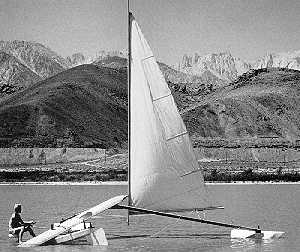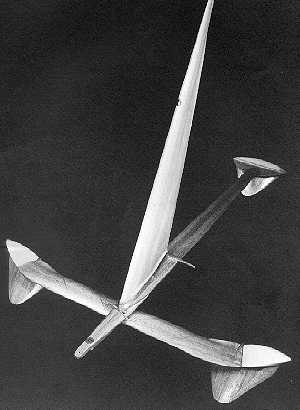Mr Smith's Amazing Sailboats
Early Work
(Section 1 of 6)
The 1950s saw Bernard Smith working for the US Navy and stationed at China Lake in
California. The periodic flooding of a local dry lake proved enough of a
temptation for him to see what type of model yacht could sail in its shallow waters, but
one whose performance would match that of the engine-powered model boats that also used
the lake.

His early models quickly worked towards a configuration of three buoyant hydrofoils arranged on a framework with a single-surface sail, as seen in the image above. Further experiments showed the performance boost gained by using an asymmetrical layout. More models followed, as did some degree of support from his colleagues for the work he was doing. Analysis provided by other scientists helped determine the behavior of the models and supported experimenting with different configurations.

By 1959, Bernard felt ready to apply what he had so far learnt to a full-sized craft. Choosing a proa configuration, this man-carrying sailboat had two buoyant foils to leeward and a small twin-ruddered planing hull. In the midst of making the proa, he learnt that he was to be re-assigned to the east coast of the US. Only two trials of his sailboat were possible before he had to leave for Rhode Island. An error in reasoning how the sail operated made controlling the craft a challenge and tacking proved impossible to do. It was, according to Bernard, "an imperfect design".

Whilst resident in Newport, Bernard continued to work on
his high-speed sailboat concepts. Analysis convinced him, that if the hydrofoil
yacht was to perform well at high speeds and in all directions, it needed an airfoil wing.
Developmental work with a series of models followed. The performance of one
particular craft, which had an airfoil "sail" and three hydrofoils,
all inclined
to windward, made him realize he was on the right track. Making full use of this
asymmetrical arrangement, Bernard went on to develop the model shown above. This
craft could change tack - the 'sail' mounted beam changing about as the craft tacked, the
rear foil staying aligned with the other two.